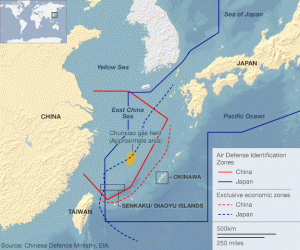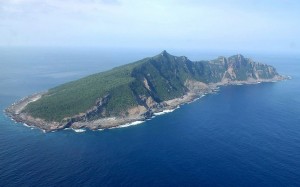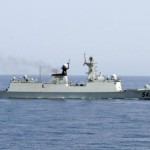Two weeks after China announced the creation of its air defence identification zone (ADIZ) in the East China Sea, the initial response to it has been a mixture of outrage and inability to do much about it. The area covers much of the East China Sea and overlaps with Japan’s existing ADIZ which includes the Senkaku/Diaoyu Islands, contested by both countries. Pressure from the US, Japan, South Korea and Taiwan has unsurprisingly amounted to no retraction of the zone, as China reiterates its prerogative to defend its maritime interests. There is no international norm for establishing air defence zones, and as such China is not breaking any international laws.
China’s Ministry of National Defence (MND) announced the ADIZ and produced a set of rules under which foreign commercial and state aircraft must abide to, or risk facing ‘defensive emergency measures’. The rules produced by the MND largely replicate rules set forth in the joint American and Canadian ADIZ in North America, however the rules and procedures are more vague and grant the MND more power of interpretation than its American counterpart. One rule which has received significant attention is the reporting of flight plans and intentions for commercial and state aircraft to China before entering the zone.
Major Japanese airlines have refused to provide such plans, likely under pressure of the government. After initially condemning the ADIZ, the US has agreed to provide flight plans for commercial airlines, but has openly flown military aircraft over the Senkaku/Diaoyu Islands and says that the ADIZ will not affect US military exercises in the region. Japan and South Korea followed suit soon after by flying their own military aircraft through the zone. Japan has since made complaints to the International Civil Aviation Organisation with support from the US, UK and Australia. They have argued that the zones existence creates an environment in which accidents are more likely to occur, in a place where rival militaries already come within an arms-length of each other.
Some experts have noted that Tokyo’s increased willingness to deal with sovereignty issues multilaterally is a sign of Abe’s desire to reinforce a regional order, that counterbalances Chinese unilateralism, by utilising international cooperation and deliberation. However, some think Japan’s blossoming propensity for multilateralism may negatively impact its claim to the Senkaku Islands, by not acting firmly enough to China’s ADIZ. As well as overlapping Japanese claimed territory, the new ADIZ also covers a submerged rock which China and South Korea contest. South Korea’s reaction has been much more compelling as it expanded its own air defence zone significantly to protect the Seoul-controlled rock. Taiwan, who remains largely the forgotten entity in the dispute over the Senkaku/Diaoyu Islands with its own claim, has called for a peaceful resolution, knowing its own sovereignty over the islands is also being threatened.
 Despite the US, Japan and South Korea all having their own ADIZ’s, China’s creation of its own zone should be understood as part of a greater strategic move rather than a tactical play. Indeed, China is not as naive to institute what would be regarded internationally as a fairly aggressive move without careful planning and diligence. The international reaction to the ADIZ may have been one of outrage, but for the most part Chinese leadership has endured very few consequences. This is Xi Jinping’s way of testing China’s regional power – what it can and can’t get away with, and how its neighbours will respond to a more aggressive regional action.
Despite the US, Japan and South Korea all having their own ADIZ’s, China’s creation of its own zone should be understood as part of a greater strategic move rather than a tactical play. Indeed, China is not as naive to institute what would be regarded internationally as a fairly aggressive move without careful planning and diligence. The international reaction to the ADIZ may have been one of outrage, but for the most part Chinese leadership has endured very few consequences. This is Xi Jinping’s way of testing China’s regional power – what it can and can’t get away with, and how its neighbours will respond to a more aggressive regional action.
China’s military modernisation is enabling it to increasingly act as a major regional power. In the South and East China Seas, where China sees itself as having vested national interests, it utilises what has been called a ‘cabbage strategy’ to secure disputed territories. This involves surrounding a disputed area, like the Senkaku/Diaoyu Islands, with as many vessels as possible – fishing boats, state fishing authority boats, surveillance vessels, warships and so forth. In surrounding a location with as many of these as they can afford, it creates a layered state-presence which makes it impossible to navigate freely around the area. The new ADIZ can be seen as another vital part in this strategy. By including the Diaoyu Islands in its ADIZ, China has expanded its cabbage strategy to the air, but has technically not breached any international laws. Experts that claim the inclusion of the Islands to be a clumsy move resulting in international outrage are shortsighted. Beijing fully understands that, sparing a military conflict, the risk associated with creating the ADIZ was fairly low. The resulting international reaction was one of many words but few actions – Joe Biden even visited Beijing a couple of days ago, which doesn’t exactly scream how outraged the US is over the situation.
Putting it bluntly, unless the US and its allies reacted militarily to the creation of the new ADIZ, China was always in the position to gain. Its tested the regional waters, and it has come out of the ordeal unscathed. Even if its neighbours don’t recognise the East China Sea ADIZ, the very fact that it exists makes it easier for China to increase its defensive and offensive protocols in the zone’s parameters. Not only that, but it also means that the creation of future Chinese ADIZ’s in surrounding waters would be easier to institute. China has already said that future ADIZ’s are being planned, most likely in the Yellow and South China Seas. Given the proximity of South Korea in the Yellow Sea and the amount of competing territorial claims in the South China Sea, this does not bode well for China’s neighbours.
Whilst the current situation is certainly an escalation in regional tensions, it has not and likely will not reach a tipping point. Calls from Japan to issue a joint statement with the US over the zones creation was considered, but not carried through by the US. This, alongside Biden’s visit, is most likely a sign that Obama is allowing China some growing space. Recognising its regional power and giving it space to breathe may result in better Sino-US relations, but it should not be at the cost of increasing friction between China and US allies. It would be in the interest of all parties to discuss and establish proper norms and protocol for the zones, as the risk for accidental conflict remains significant, especially between Japan and China. Seeing that regional foreign policy in East Asia mostly consists of the politics of pride, cooperating comprehensively on regional security is difficult. However, given the global importance of the East Asian economies and the domestic problems that the involved countries are experiencing, they owe it to themselves and the region to deal with things diplomatically.
This article was also published on www.asiapacificsecurity.com (@AsiaPacificSec)
Find more articles by Peter here
_________________________________________________________
Related articles
How serious is the recent China-Japan verbal escalation?
This past week has seen a war of words between China and Japan. Though not an unfamiliar situation, China and Japan have been locked in a face-off over several issues and tension between them has risen significantly. Whilst the Senkaku/Diaoyu dispute continues to be a thorn in the side of political progress, friction between the two largest economies in Asia has become more intense…
More related articles in the categories Related articles in the categories Asia and Australasia, Warfare


